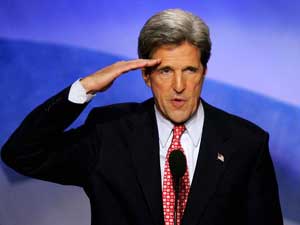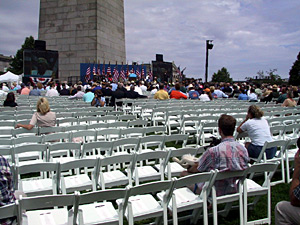Like the ceremonial first pitch at a baseball game, the lament that there’s no news at a political convention officially kicks off the convention coverage season.
Jack Shafer, writing in Slate, has tossed the first pitch.
A still better way to improve convention coverage would be to withdraw all reporters and force the curious to rely on a C-SPAN feed: Unless a brokered convention threatens to break out, these political gatherings tend to produce very little real news. Yet the networks, the newspapers, the magazines, and the Web sites continue to insist on sending battalions of reporters to sift for itsy specks of information. According to Forbes, 15,000 pressies are expected to attend each of the conventions. Slate, I’m embarrassed to admit, is sending a team of eight to Denver and six to St. Paul. Attention! Don Graham! We’re spending your cash like it’s Zimbabwean bank notes!
Shafer is correct, at least to the extent that far too many mainstream journalists — and even more in the blogosphere — believe that convention coverage involves sitting in a darkened hall somewhere and waiting for someone to deliver a tinkle of news. But why would they? It’s a rehearsed infommercial, and this isn’t 1968.
So what’s a reporter to do? Leave. Look for a better location to learn the real stories behind the script from which the Dems and Republicans want the media to read. Eventually, they reveal their true selves and deliver a far better story.
 I’ve used this story before, but Shafer hasn’t heard it, obviously. It’s Boston 2004, the Democrats have trotted out the image campaign to make John Kerry a war hero. The former Fleet Center was bedecked in pictures of Kerry in Vietnam, all intended to provide some salve to the wounds inflicted by the Swift Boat Veterans.
I’ve used this story before, but Shafer hasn’t heard it, obviously. It’s Boston 2004, the Democrats have trotted out the image campaign to make John Kerry a war hero. The former Fleet Center was bedecked in pictures of Kerry in Vietnam, all intended to provide some salve to the wounds inflicted by the Swift Boat Veterans.
The message: Democrats are patriotic, too. It was a carefully crafted message swallowed hook, line, and sinker by the major media. But on one morning, after a late-night convention session, an event was scheduled on Bunker Hill — a salute to veterans. Most reporters didn’t go, figuring there was no news to be had. That, and it was a mile away from Fleet Center.

Thousands of Democratic delegates stayed away from the event. Had reporters spent more time looking for these angles instead of lamenting the lack of news, perhaps more than one news outlet would’ve told you the story of the convention that was reluctant to “salute the vets.”
Fast-forward to New York City weeks later. The Republicans draped themselves in 9-11. Widows speak to a hushed convention. “We will not forget,” becomes the rallying cry.
A day later, Minnesota delegates to that convention refuse to take the time to talk with another group of widows and survivors — the ones whose loved ones’ remains are buried in a Staten Island garbage dump; the ones who can’t get sympathy from either the Republican mayor or the Republican governor of New York. As they’re touring the site, I tell the delegates about the group of families. They return to their buses instead.
Here’s the slideshow I put together at the time (Sorry it’s in RealAudio format, it was 2004.)
In San Diego in 1996, a “Faith and Freedom” rally became a metaphor for the party as a whole. The far-right evangelicals were allowed in; the moderates stayed home.
In Boston, we started a dialog on whether Catholic Democrats have an obligation to their Church and faith that supersedes that to their constituents? That didn’t appear on any agenda.
And in New York, Laura McCallum was one of the first people to analyze the possibility of a national role for Gov. Tim Pawlenty. That was four years ago, and people going into that convention forget that it was Sen. Norm Coleman, not Gov. Tim Pawlenty, who was considered a rising star of the party. Pawlenty got the love tap from the head of the Club for Growth, the ultra-conservative kingmakers.
By looking for news, MPR did an outstanding job finding the stories, and we’re poised to provide even more over the next few weeks.
We’re obviously not the only ones looking — and finding — these stories. And, sure, it’s unclear whether we’ll find their equals in Denver or St. Paul. But if we don’t, it will only be because we didn’t look hard enough.
It’s our job to ignore the infommercial. But Shafer’s suggestion — staying home — isn’t the way to do it.
Update 12:13 Media lecturer Jeff Jarvis gets his licks in, too. But remember, that’s a journalism “expert” advocating journalists stay home and just steal other people’s work. If you haven’t looked for the news, how do you know it’s not there?
